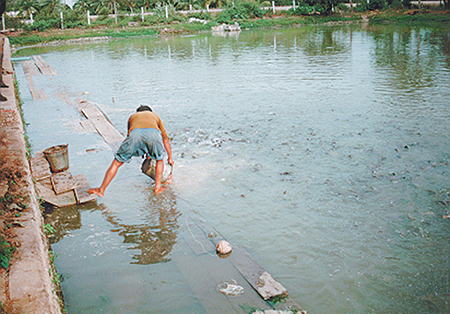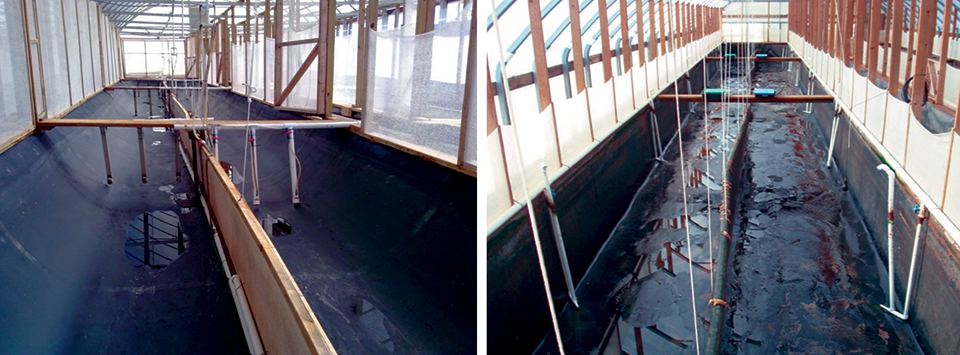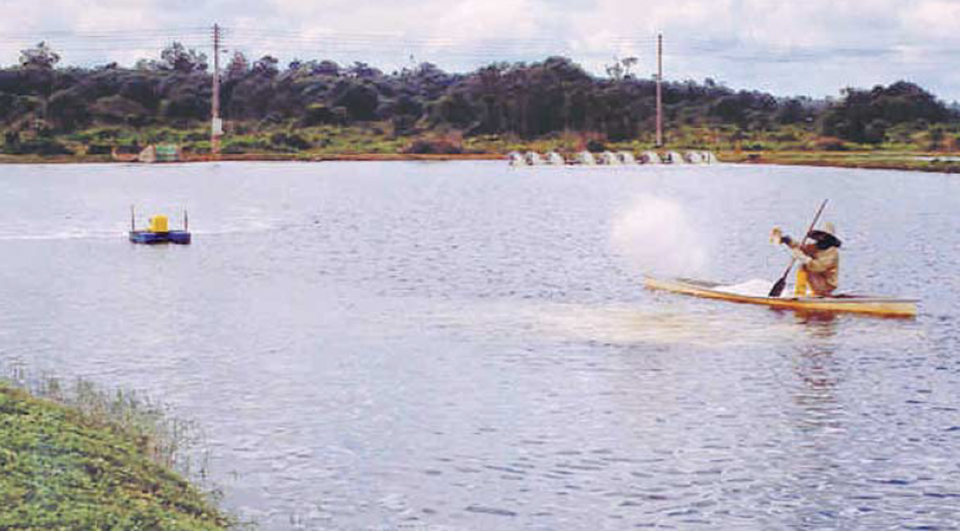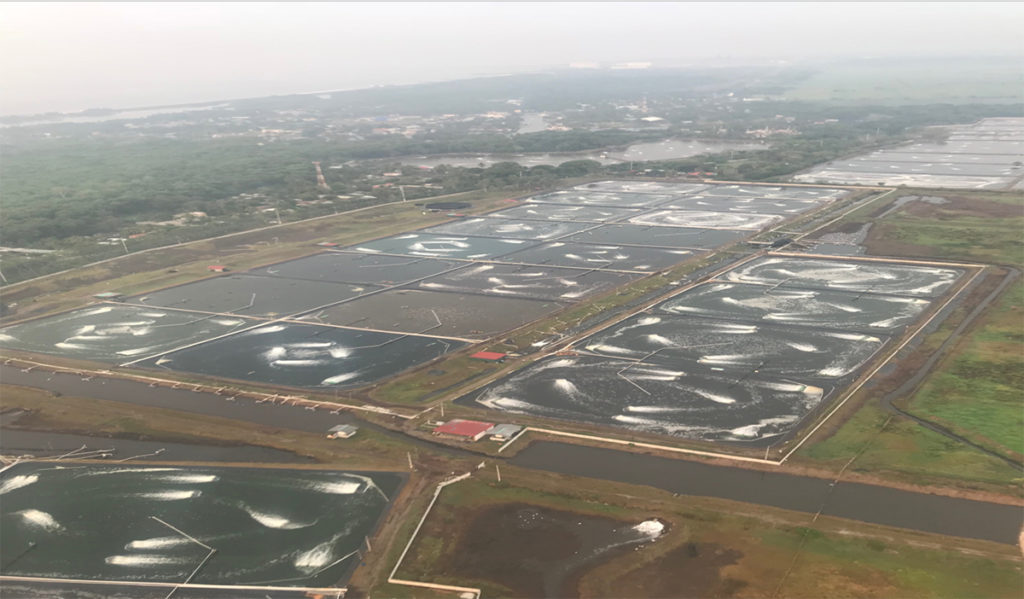Tailored policies must reflect production diversity

The production of farmed aquatic animals is dependent on the supply of nutrient inputs, applied either directly in the form of food organisms and/or aquafeeds, or indirectly as fertilizers. The rates of supply and assimilation of these nutrients play a major role in dictating the nutrient and/or waste outputs from production facilities. Such outputs vary, depending on the farming system employed (open or closed), and the feed and water-management programs in place at each farm.
Wastewater outputs
Wastewater outputs include effluents or wastewaters that contain dissolved or suspended, organic or inorganic matter. They result from:
- Feed/nutrient inputs, either directly in the form of uneaten/wasted feed and the end products of feed digestion and metabolism, or indirectly through eutrophication and increased natural productivity.
- Chemical inputs, either directly within feed as medicants or feed additives, or indirectly through chemical usage during normal farm husbandry operations.
- The periodic disposal of pond/tank sediments at the end of culture cycles.
- Agricultural and industrial water runoff and/or contamination through precipitation or leaching.
- The release of aquatic pathogens and animals.
Intensity and impact
In general, as intensity and scale of farm production rise, greater nutrient inputs are required. In consequence, the potential for environmental impacts emerging from the aquaculture facility also rises. In these respects, conventional aquatic food-production systems are no different from their terrestrial counterparts.
Cold-blooded aquatic species
However, where terrestrial animal farming is restricted to a handful of warm-blooded livestock species under relatively uniform rearing conditions, aquaculture is currently based on the production of a multitude of cold-blooded species. In 1999, these included 125 finfish species, 48 mollusk species, and 27 crustacean species within an equally wide range of production units, farming systems, and environments.
Environmental policies
To date, the major approaches taken by government authorities within the major aquaculture-producing countries to minimize the potential feed-related environmental impacts of farm effluents have included:
- Required treatment of farm effluents prior to discharge, through the use of settlement basins, filtration devices, treatment systems, etc.
- Limits on the concentrations and total amounts of specific materials and/or nutrients in discharged effluents.
- Limits on farm licenses and/or farm size.
- Limits on the total quantity of feed applied over a fixed time period.
- Limits on nutrient levels within compound feeds.
- Bans on potentially high-risk feed items, such as fresh/trash fish and invertebrates.
- Bans on chemicals, including therapeutants, drugs, and other chemicals (potentially toxic herbicides and pesticides).
- Prescribed feed performance criteria, such as efficiency or nutrient digestibility.
- Codes of conduct, including appropriate practices for farm operations, feed manufacture and use, and environmental management.
- Required development of sediment management.
- Implementation of environmental monitoring.
No single solution
The many policy options above reflect the diversity of farming systems and species cultivated around the world, and the different approaches used by government authorities and/or farming associations to deal with aquaculture effluents.
Clearly, where aquaculture is an important provider of food and/or employment, government policies should be flexible enough to address the varied species, farming systems, and rearing environments found within the country in question. Such policies should also be practical and enabling to facilitate the continued economic growth of the sector. In addition, they must protect the environment for other users, while also protecting the aquaculture sector from other water users and potential environmental polluters.
Conclusion
There are many suitable ways of supplying nutrients to targeted culture species that are not detrimental to the aquatic environment and other land users. As with terrestrial agricultural food-production systems, policies aimed at regulating aquaculture effluents and outputs are more beneficial for the continued diversity and health of the sector than regulation of feed inputs and feeding practices. Feed regulation should be used primarily where effluent measurement is exceptionally difficult, as in the case of open-ocean aquaculture.
Note: This article is part of a review paper to be presented by the authors at the“Management of Aquaculture Effluents” workshop to be held May 6-9 in Honolulu, Hawaii, USA.
(Editor’s Note: This article was originally published in the April 2002 print edition of the Global Aquaculture Advocate.)
Now that you've reached the end of the article ...
… please consider supporting GSA’s mission to advance responsible seafood practices through education, advocacy and third-party assurances. The Advocate aims to document the evolution of responsible seafood practices and share the expansive knowledge of our vast network of contributors.
By becoming a Global Seafood Alliance member, you’re ensuring that all of the pre-competitive work we do through member benefits, resources and events can continue. Individual membership costs just $50 a year.
Not a GSA member? Join us.
Authors
-

Albert G.J. Tacon, Ph.D.
Aquatic Farms Ltd.
49-139 Kamehameha Highway
Kaneohe, Hawaii 96744 USA
atacon@msn.com[109,111,99,46,110,115,109,64,110,111,99,97,116,97]
-
Ian P. Forster, Ph.D.
The Oceanic Institute
Waimanalo, Hawaii, USA
Tagged With
Related Posts

Responsibility
Advances in super-intensive, zero-exchange shrimp raceways
Research at the Texas AgriLife Research Mariculture Laboratory is investigating ways to improve the economic viability of super-intensive raceways for shrimp production.

Responsibility
Chemical fertilizers in pond aquaculture
Chemical fertilizers are frequently used in pond aquaculture to stimulate phytoplankton productivity and enhance the availability of natural food organisms.

Intelligence
10 takeaways from GOAL 2019 in Chennai, India
The Global Aquaculture Alliance held its GOAL conference in Chennai, India, and recruited a host of experts in various fields to share their expertise.

Responsibility
Shrimp farming in Guatemala has gone intensive
Guatemala’s shrimp-farming growth is due to a highly intensive system of small ponds and shorter cycles. Production of close to 25,000 metric tons is expected in 2018.


